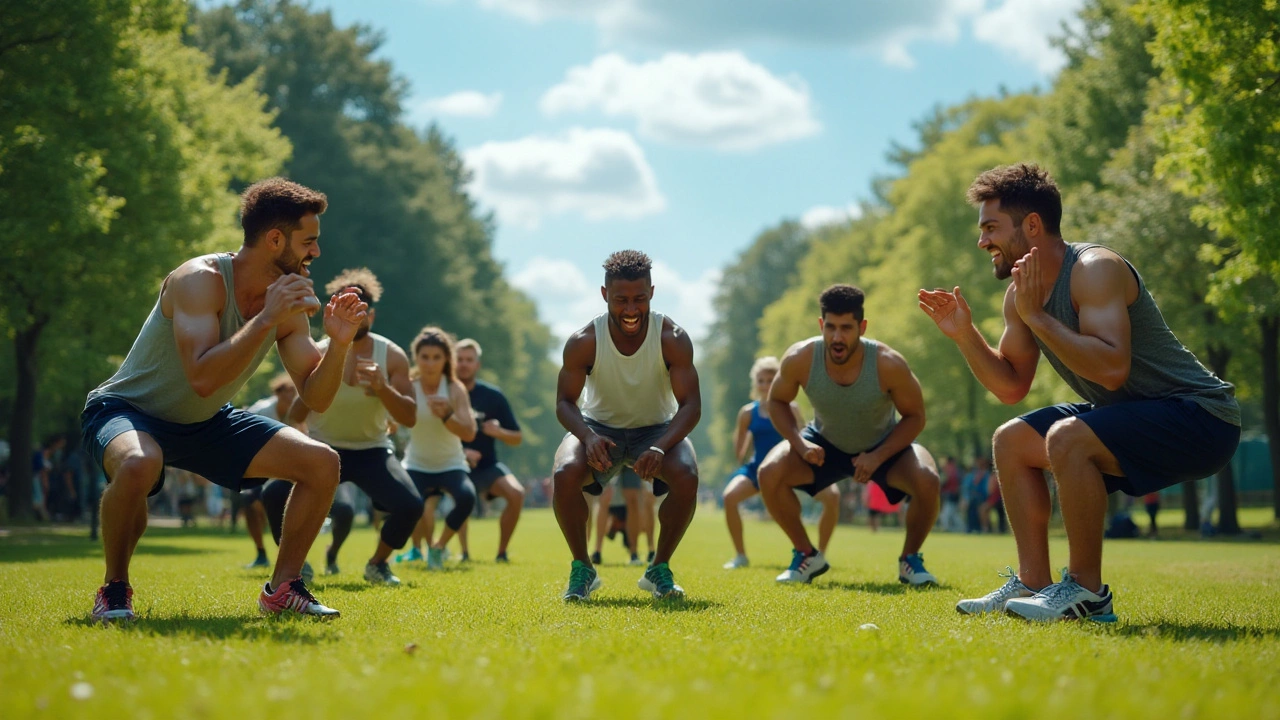
Embarking on a journey of strength training can be both exciting and bewildering. One question that often pops into the minds of eager fitness enthusiasts is: "Which muscles will grow the fastest?" The answer, rooted in both science and practice, can greatly influence how you structure your workout regimen.
Some muscle groups are known to respond more quickly to exercise than others. Focusing on these can accelerate your progress and keep your motivation high as you see noticeable changes in a relatively short time.
Let's delve into the fascinating world of muscles, exploring how to maximize your strength training for quick and effective results. Whether you're a seasoned gym-goer or just starting out, understanding how your body reacts to different exercises can lead to more informed and successful workouts.
To truly appreciate the marvel of muscle growth, we need to dip our toes into the confluence of biology and physical exertion. At its core, muscle growth, scientifically coined as hypertrophy, occurs when muscle fibers endure tiny tears from strenuous activity. The body, in its brilliance, repairs these tears and goes a step further, reinforcing the fibers so they're beefier, sturdier versions of their old selves. While genes play their part, everyone is sculpted by their unique dance of effort, rest, and sustenance. What's fascinating is that specific muscles, like those of the arms and shoulders, often gain mass more rapidly than others, offering a sort of instant gratification to new lifters eager to see results.
Hormones such as testosterone and growth factors like IGF-1 play orchestra conductors in this symphony, directing the body's resources to repair and grow muscle tissue. Both men and women possess these natural growth enhancements, though in different quantities. Interestingly, starting a fitness regimen will ignite faster changes across these hormone levels due to the body's need to adjust. Adaptability is built into us. There's a mental game too: as the mind becomes accustomed to consistent resistance training, it bolsters the body's capability to recruit more muscle fibers with each exercise.
A pivotal aspect of this growth saga is nutrition. Providing muscles with the proper fuel is vital. Think of proteins as the structural bricks and carbohydrates as the energy mortar binding the process. Consuming an adequate array of vitamins and minerals ensures the construction team—which is your body—remains productive. Without balanced nutrition, even rigorous training can lead to a stalled progression. It's a delicate weave of workload and nourishment that creates results.
Knowing these ins and outs helps craft a personalized approach to exercise. Strength training isn't one-size-fits-all because our bodies sing their own tunes. Understanding these intricacies lets you adjust that tune for harmonious growth tailored to your physiology. Such knowledge empowers, clarifying why some days you're lifting lighter than a breeze and others you're unstoppable. It's an awe-inspiring combination of biology you can feel daily.
"Training gives us an outlet for suppressed energies created by stress and thus tones the spirit just as exercise conditions the body." - Arnold Schwarzenegger
Finally, there's the power of rest. Many forget that without proper recovery, the gains made are gains lost. It’s during this downtime that the real magic happens; muscles recuperate and fortify. Neglecting rest tilts the balance, leading to wear rather than growth. So, celebrating those rest days as vital to the process becomes monumental. Let's embrace this as the beautiful science, art, and mystery of our bodies in action.

Understanding which muscles grow quickly can provide an edge in sculpting your ideal physique, helping you to focus on the exercises that yield noticeable results. While muscle growth is complex, some muscles, thanks to their unique fiber composition and functional demands, tend to develop more rapidly than others. One notable group is the pectorals. With larger fibers and frequently engaged in everyday activities, these chest muscles respond well to weightlifting. The pecs often show quick improvements when subjected to bench presses and flys, making them a favorite among those looking to bulk up.
Another group with a reputation for quick growth is the quadriceps. These powerhouse muscles at the front of your thighs see constant use, from walking to more intense activities like cycling and squatting. Because of their role in supporting the body's largest weight-bearing bones, the quads can bulk up noticeably with targeted workouts. Squats, leg presses, and lunges are terrific for tapping into this growth potential. The outer upper arms, the biceps, also tend to grow swiftly. It's common to see individuals diligently curling dumbbells, as these exercises strengthen this muscle group. Regularly activated during pulling actions, biceps can enlarge significantly with consistent effort.
"Muscle growth can be rewarding when you understand the body's natural tendencies," remarks Dr. Jane Simmons, exercise physiology expert at a leading Australian sports institute. "Leveraging fast-growing muscle groups means not just quicker gains, but also a motivated training experience."
In addition, maintaining varied routines helps in not only targeting specific fast-responding muscles but also prevents adaptation plateaus. Muscles become accustomed to particular movements over time, slowing growth if the routines become monotonous. Alternating exercises and incorporating machine work alongside free weights can break monotony and stimulate muscles differently. A balanced training schedule, possibly incorporating different muscle groups each session, keeps the muscle growth robust and balanced.

When you're aiming to grow muscles swiftly, integrating effective strength training techniques can make a world of difference. One crucial aspect is the incorporation of compound exercises. These are workouts designed to engage multiple muscle groups simultaneously, intensifying your sessions and promoting faster muscle growth. Think of exercises like squats, deadlifts, and bench presses. Squats, for example, do not just target your quadriceps; they also work your glutes, hamstrings, and core. The complexity and intensity of these exercises trigger your body to react, stimulating quicker gains. Such movements are pivotal in a balanced strength routine, ensuring you maximize growth with each session.
Progressive overload is another key concept every eager trainee should embrace. It involves gradually increasing the weight, frequency, or number of repetitions in your workouts. This method compels muscles to adapt to the stimulus by growing stronger and, essentially, larger. An interesting fact about progressive overload is that it's not just about lifting heavier each time. Sometimes, altering the tempo or reducing rest intervals can provide the necessary push. Yet, a consistent and well-structured plan is paramount to reap the benefits without risking injury. As renowned strength coach Bret Contreras puts it,
"Adaptation is the name of the game. If you want your muscles to grow, they need to be pushed beyond what they're used to."
Another cornerstone in the quest for fast gains is focusing on frequency. Training certain muscles at higher frequencies might yield better results compared to traditional routines. For instance, if you're looking to bulk up your chest, instead of dedicating one day a week to it, you might want to engage the chest muscles at least two to three times a week. This doesn't imply performing exhaustive workouts every day but rather varying intensity and volume to keep the muscles engaged consistently over the week. Such a technique not only accelerates growth but ensures that the muscles remain responsive.
Let's not overlook the value of incorporating time-under-tension into your regimen. By prolonging the duration your muscles are under stress during exercise, you effectively promote hypertrophy. This method involves slowing down your repetitions, emphasizing control throughout the movement to amplify the workload on the targeted muscles. For example, when performing a bicep curl, consider extending the lift phase to three seconds, holding it for a second, and then taking another three seconds to lower it. Strategies like this often lead to enhanced muscle growth, tackling the issue from multiple angles.
Utilizing such training techniques requires dedication, insightful planning, and, importantly, a willingness to listen to your body's needs and limits. Whether you're a beginner or a seasoned athlete, implementing these strategies can introduce a fresh perspective to your workout regimen. Remember, achieving quick gains is about the smarter work, not necessarily harder, and with the right approach, you're bound to see satisfactory results.

To truly maximize your muscle growth, it is essential to give equal attention to what happens outside the gym. Nutrition and recovery are key players in this game, and understanding how to fuel and rest your body can lead to remarkable improvements in your strength and size. First and foremost, protein is the cornerstone of muscle growth. As a building block of muscles, ensuring you consume enough protein daily is critical. Aim for at least 1.6 to 2.2 grams of protein per kilogram of body weight. Such protein-rich foods include chicken, fish, eggs, and legumes. Besides, integrating a variety of protein sources prevents dietary monotony and ensures a broad spectrum of nutrients.
Carbohydrates are often misconceived as being detrimental to health; however, they are an essential energy source during the physical exertion from strength training. Complex carbohydrates, such as quinoa and brown rice, provide a slow release of energy and should be strategically included in pre- and post-workout meals. In this context, carbs help replenish glycogen stores that get depleted during exercise, allowing muscles to rejuvenate more efficiently.
"By consuming a combination of proteins and carbohydrates after workouts, you optimize muscle protein synthesis—which is foundational for muscle recovery and growth," notes Dr. Mike Israetel, sports nutrition expert.
Moreover, hydration is a component that cannot be overlooked. Muscles are composed of over 70% water; thus, staying hydrated aids in the transportation of nutrients and smooth muscle contractions. Make it a habit to drink plenty of water throughout the day, complementing your fluid intake with natural electrolytes like those found in coconut water or a pinch of sea salt.
As vital as the intricate details of diet are relaxation and sleep, key aspects of recovery that fast-track your progress. During deep sleep phases, the body ramps up the production of growth hormone, a vital catalyst for muscle repair and growth. Strive for at least 7 to 9 hours of quality sleep each night. To enhance sleep quality, create an evening routine that involves winding down electronic devices and relaxing through yoga or meditation techniques.
Strategically including rest days within your training regimen is equally important. Muscles need time to repair themselves from the microtears incurred during strenuous workouts. Rest days serve as planned recovery periods, preventing overtraining which can lead to injuries. Active recovery days, including light activities such as walking or swimming, can also facilitate better blood flow to muscles, accelerating healing.
Tracking and adapting your nutritional and recovery strategies based on how your body responds is a dynamic and ongoing process. Visit your healthcare provider regularly to monitor your progress and ensure your strategies align with your fitness goals. Infusing these recovery tips into your lifestyle not only promotes quicker muscle growth but also enhances overall well-being.